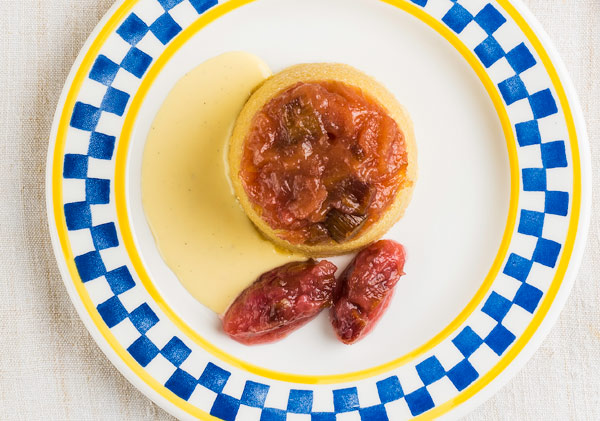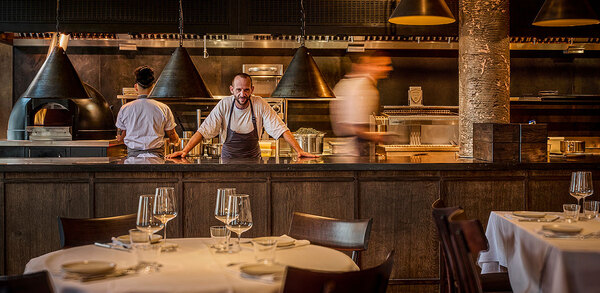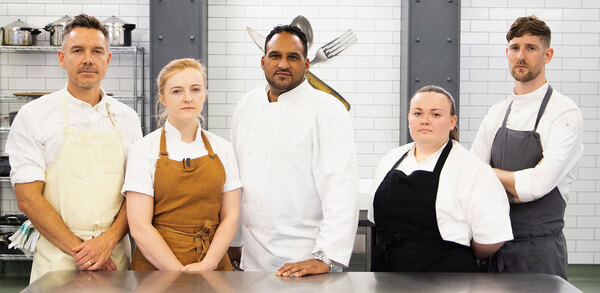Home-grown harvest: outdoor rhubarb
There's more to rhubarb than the Yorkshire forced variety, with recipes spanning both sweet and savoury. Russell Brown reports
Tender, blushing pink stems of the finest Yorkshire forced rhubarb must be on virtually every chef's menu in the early months of the year. Rhubarb brings intense flavour, freshness and a real splash of colour to many dishes when there is little else around in the way of new season British produce.
As we move into early April, though, the forced rhubarb comes to an end and, for many chefs, that's it until next year. However, a new crop with many virtues of its own is just about to start.
Outdoor rhubarb really is a viable alternative to the forced variety. You can't escape the fact that there's a colour difference, but it is, perhaps, less marked these days, with outdoor varieties such as Raspberry Red, Timperley Early and Champagne all exhibiting vibrant colour.
Rhubarb is the vegetable stalk of a herbaceous perennial and so, technically, is a vegetable, but in culinary terms it is generally treated as a fruit. The leaves contain toxic substances which can cause poisoning, with oxalic acid being the main culprit. The stems contain a much smaller proportion of oxalic acid, with most of the sour flavour coming from malic acid. Outdoor rhubarb may be less tender than forced but this partly depends on size and variety. The flavour of outdoor rhubarb can also be more intense than the forced variety.
Rhubarb can be forced outdoors by covering the plants with black polythene or traditional forcing pots. This is a distinctly different process than that used for Yorkshire forced rhubarb, which has been granted protected designation of origin status by the EU. Forcing of outdoor varieties can mean a crop that starts a few weeks earlier than unforced but the main outdoor rhubarb season starts in late March or early April and runs until June or July.
The choices for cooking with rhubarb are vast and both sweet and savoury options are equally viable. On the savoury side, rhubarb can be pickled, made into chutneys, coleslaws, compotes and ketchup. Rhubarb works particularly well in a dish whenever some acidity is needed to balance out the flavours; oily or fatty meat and fish, cheeses and pies all pair well with savoury rhubarb
recipes; for example, duck confit with raw pickled rhubarb, cheese with rhubarb and ginger chutney, or mackerel served with a simple rhubarb compote.
Rhubarb is perhaps best known for its versatile use in desserts. In sweet dishes, rhubarb can be stewed, roasted, baked, dried and cooked sous vide. The latter method is a good way to ensure rhubarb that is tender but still holds its shape. A purée of rhubarb can be used to make fools, the juice from briefly stewed stems can be used for a jelly and recipes for tarts and crumbles abound.
Rhubarb is often paired with ginger, strawberries, rosewater, orange and anything creamy. At the Barbican Kitchen in Plymouth, Devon, Chris and James Tanner are using outdoor rhubarb for a rhubarb and frangipane tart with clotted cream, while chef Mark Hartstone at La Fosse in Cranborne, Dorset, makes a rhubarb and ginger preserve that he uses with both sweet and savoury dishes.
Pulled pork buns with rhubarb and chilli relish

Serves 8-12 (depending on portion size)
For the pork
1tsp ground cumin
2tsp fennel seeds, toasted and ground
1tsp smoked paprika
15g flaky sea salt
4 cloves garlic, crushed
50ml olive oil
20g chipotle paste
1.5kg bone-in pork spare rib
3 onions, roughly chopped
200ml light chicken stock
75ml tomato passata
For the rhubarb and chilli relish
1 onion, finely diced
20ml olive oil
1 clove garlic, crushed
1 red chilli, deseeded and diced
1 small pinch chipotle chilli flakes
1tsp mustard seeds
300g rhubarb, sliced into ½cm pieces
80g caster sugar
75ml white wine vinegar
To serve
8-12 brioche buns
2-3tbs mayonnaise
2 gem lettuce or similar
2 avocados, peeled and sliced
16 cornichons, sliced
Mix the spices for the pork with the salt, garlic, oil and chipotle paste. Take the skin off the pork and score the fat. Pierce the pork all over and rub in the marinade. Wrap tightly and refrigerate for 24 hours. Place the onions, stock and passata in a small roasting tin and put the pork on top. Roast at 230°C for 20 minutes then cover with silicone paper and wrap tightly with foil.
Reduce the oven temperature to 130°C and cook for three to four hours until the pork pulls apart easily. Remove the pork, skim excess fat from the roasting tin and reduce the liquid until it is slightly thickened. Mix in the pulled pork and season to taste.
For the relish, sweat the onion in the oil until slightly softened. Add the garlic, chillis and mustard and cook for a further minute. Add the rhubarb, sugar and vinegar and simmer until thick and syrupy. Adjust the seasoning and add more sugar or vinegar if required.
To serve, split and toast the buns and spread with mayonnaise. Add lettuce leaves, the warm pulled pork and avocado slices. Scatter over the cornichons and spoon on the rhubarb relish.
Steamed rhubarb and ginger sponge pudding
Serves 6
For the rhubarb and ginger compote
300g rhubarb cut into 1cm pieces
2 pieces stem ginger, finely diced
1cm piece root ginger, finely grated
100g caster sugar
50ml water
For the sponge
150g unsalted butter
150g golden caster sugar
3 large free range eggs, beaten
150g self-raising flour
3g salt
Milk to dropping consistency
To serve
Vanilla custard or cream
Rhubarb compote
Roasted or poached rhubarb pieces
Combine all the ingredients for the compote in a small pan, bring to a simmer and cover. Cook until the rhubarb has broken down completely then remove the lid and reduce to a jam-like consistency. Allow to cool.
For the sponge, cream the butter and sugar until light and fluffy and then add the egg in three additions, interspersed with a little flour. Fold in the remaining flour and salt. Add milk to dropping consistency.
Butter and flour six individual plastic pudding basins and place a generous spoonful of compote in each. Tap to level and then fill to three-quarters full with the sponge mix. Place lids on the basins or wrap in clingfilm and steam at 95°C for 15-20 minutes until the sponge is risen and firm to the touch.
Allow the sponges to cool for a few minutes and then turn out. Serve with more compote, cream or custard and pieces of poached or roasted rhubarb if desired.
Market report
Due to bad weather in March we are expecting outdoor rhubarb to arrive on the market three to four weeks late this year. There is Dutch rhubarb available now but the prices are very high. As soon as the English rhubarb is plentiful prices drop significantly. The English outdoor season finishes in September. As the weather has made price unpredictable, please check with your wholesaler.
Ashley Clemence, Total Produce www.totalproducelocal.co.uk
Buying and storage tips
- Stems should be crisp
- They should release sap when snapped
- Stored in the fridge, rhubarb should keep for 1-2 weeks
- The colour varies from green through to deep red but is not an indicator of ripeness
- The leaves are poisonous so should be discarded.




















